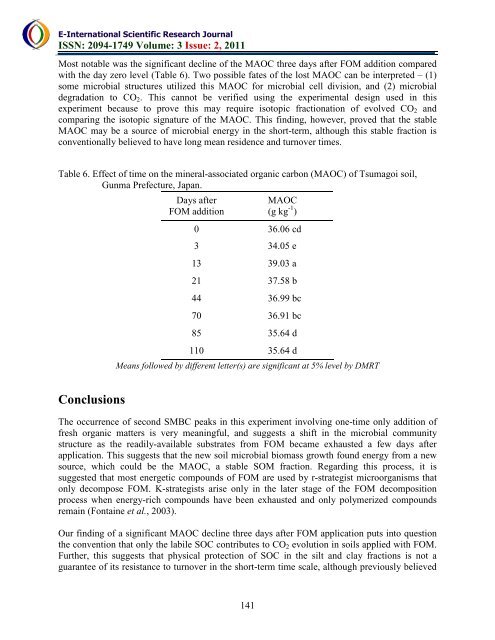download the full article here - E-International Scientific Research ...
download the full article here - E-International Scientific Research ...
download the full article here - E-International Scientific Research ...
You also want an ePaper? Increase the reach of your titles
YUMPU automatically turns print PDFs into web optimized ePapers that Google loves.
E-<strong>International</strong> <strong>Scientific</strong> <strong>Research</strong> Journal<br />
ISSN: 2094-1749 Volume: 3 Issue: 2, 2011<br />
Most notable was <strong>the</strong> significant decline of <strong>the</strong> MAOC three days after FOM addition compared<br />
with <strong>the</strong> day zero level (Table 6). Two possible fates of <strong>the</strong> lost MAOC can be interpreted – (1)<br />
some microbial structures utilized this MAOC for microbial cell division, and (2) microbial<br />
degradation to CO 2 . This cannot be verified using <strong>the</strong> experimental design used in this<br />
experiment because to prove this may require isotopic fractionation of evolved CO 2 and<br />
comparing <strong>the</strong> isotopic signature of <strong>the</strong> MAOC. This finding, however, proved that <strong>the</strong> stable<br />
MAOC may be a source of microbial energy in <strong>the</strong> short-term, although this stable fraction is<br />
conventionally believed to have long mean residence and turnover times.<br />
Table 6. Effect of time on <strong>the</strong> mineral-associated organic carbon (MAOC) of Tsumagoi soil,<br />
Gunma Prefecture, Japan.<br />
Days after<br />
FOM addition<br />
MAOC<br />
(g kg -1 )<br />
0 36.06 cd<br />
3 34.05 e<br />
13 39.03 a<br />
21 37.58 b<br />
44 36.99 bc<br />
70 36.91 bc<br />
85 35.64 d<br />
110 35.64 d<br />
Means followed by different letter(s) are significant at 5% level by DMRT<br />
Conclusions<br />
The occurrence of second SMBC peaks in this experiment involving one-time only addition of<br />
fresh organic matters is very meaningful, and suggests a shift in <strong>the</strong> microbial community<br />
structure as <strong>the</strong> readily-available substrates from FOM became exhausted a few days after<br />
application. This suggests that <strong>the</strong> new soil microbial biomass growth found energy from a new<br />
source, which could be <strong>the</strong> MAOC, a stable SOM fraction. Regarding this process, it is<br />
suggested that most energetic compounds of FOM are used by r-strategist microorganisms that<br />
only decompose FOM. K-strategists arise only in <strong>the</strong> later stage of <strong>the</strong> FOM decomposition<br />
process when energy-rich compounds have been exhausted and only polymerized compounds<br />
remain (Fontaine et al., 2003).<br />
Our finding of a significant MAOC decline three days after FOM application puts into question<br />
<strong>the</strong> convention that only <strong>the</strong> labile SOC contributes to CO 2 evolution in soils applied with FOM.<br />
Fur<strong>the</strong>r, this suggests that physical protection of SOC in <strong>the</strong> silt and clay fractions is not a<br />
guarantee of its resistance to turnover in <strong>the</strong> short-term time scale, although previously believed<br />
141

















